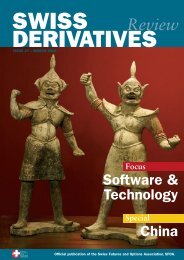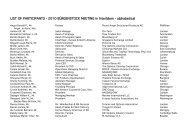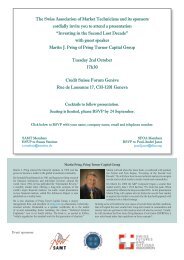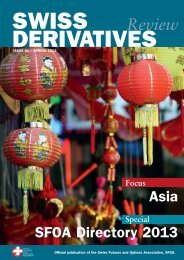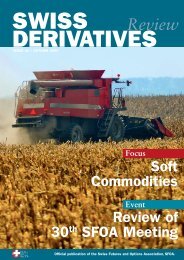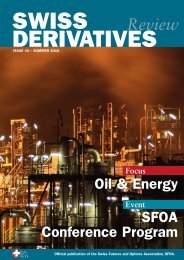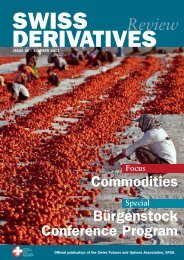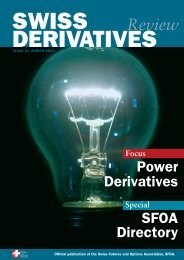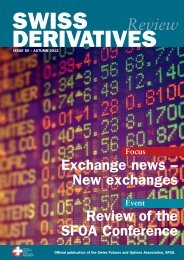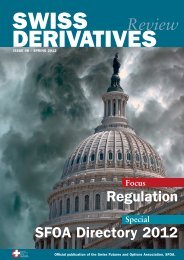Download PDF, Issue 26 - Swiss Futures and Options Association
Download PDF, Issue 26 - Swiss Futures and Options Association
Download PDF, Issue 26 - Swiss Futures and Options Association
You also want an ePaper? Increase the reach of your titles
YUMPU automatically turns print PDFs into web optimized ePapers that Google loves.
“These results seriously<br />
question the diversification<br />
rationale for engaging<br />
in Alternative Investments.”<br />
Hedge Funds<br />
Chart 2: Correlation of Returns between Hedge Fund Indices, Equities <strong>and</strong><br />
Bonds, 1999–2004.<br />
Comparing Strategies A <strong>and</strong> B, one<br />
would likely be tempted to infer that a<br />
probability of positive return of about<br />
50 bp., for instance, is higher for<br />
Strategy A than for Strategy B. Based on<br />
the frequency of returns, it is hard to dispute<br />
that point, since the returns on<br />
Strategy A have a mean of 48 bp. <strong>and</strong> a<br />
st<strong>and</strong>ard deviation of only 45 bp. The<br />
returns on Strategy B, on the other h<strong>and</strong>,<br />
display a st<strong>and</strong>ard deviation of 179 bp.,<br />
or about 4 times greater.<br />
According to the transitive principle<br />
<strong>and</strong> taking this logic further, the probability<br />
of a positive return above +0.5%,<br />
say 2%, for Portfolio A should always<br />
exceed the corresponding probability for<br />
Portfolio B.<br />
35<br />
Again, the clustering of Hedge Fund<br />
returns in the top right quadrant does<br />
not differ much from the previous picture.<br />
Outliers are still the same as before.<br />
Similar plots emerge for returns during<br />
shorter periods between May 1999 <strong>and</strong><br />
May 2004.<br />
What does this mean? For all the<br />
diversification benefits that hedge fund<br />
managers are supposed to bring to<br />
investors, it is simply too risky – <strong>and</strong><br />
politically incorrect – to underperform<br />
traditional asset classes when these<br />
exhibit positive returns. Simply put, two<br />
different risk frames are at play to make<br />
investors’ perspective lop-sided in their<br />
Hedge Fund performance assessments:<br />
• during downturns, investors are biased<br />
to focus on the relative performance,<br />
i.e. they lose less than long-only strategies;<br />
any positive absolute return that<br />
they can produce is icing on the cake;<br />
• during uptrends, investors praise hedge<br />
funds’ lower risk relative to long-only<br />
strategies – which makes up for the<br />
underperformance bias of the former<br />
category vis-à-vis the latter.<br />
As risk-adjustment in Alternative<br />
Investments relies overwhelmingly on<br />
historical simulation alone (see the next<br />
point), there is no way to include in the<br />
process the significant correlations<br />
shown earlier.<br />
Frequency <strong>and</strong> probability of<br />
returns,<br />
Consider the following chart:<br />
P A(0.5%) > P B(0.5%)<br />
P A(2%) > P B(2%)<br />
<strong>and</strong>, in addition,<br />
P A(2%) < P A(0.5%)<br />
This way of thinking assumes implicitly<br />
that underlying prices may follow a continuous<br />
function. Market prices, however,<br />
can <strong>and</strong> do experience discontinuities,<br />
Chart 3: Using Frequency in Drawing Probability Assessments for Trading<br />
Strategies.<br />
SWISS DERIVATIVES REVIEW <strong>26</strong> – NOVEMBER 2004




